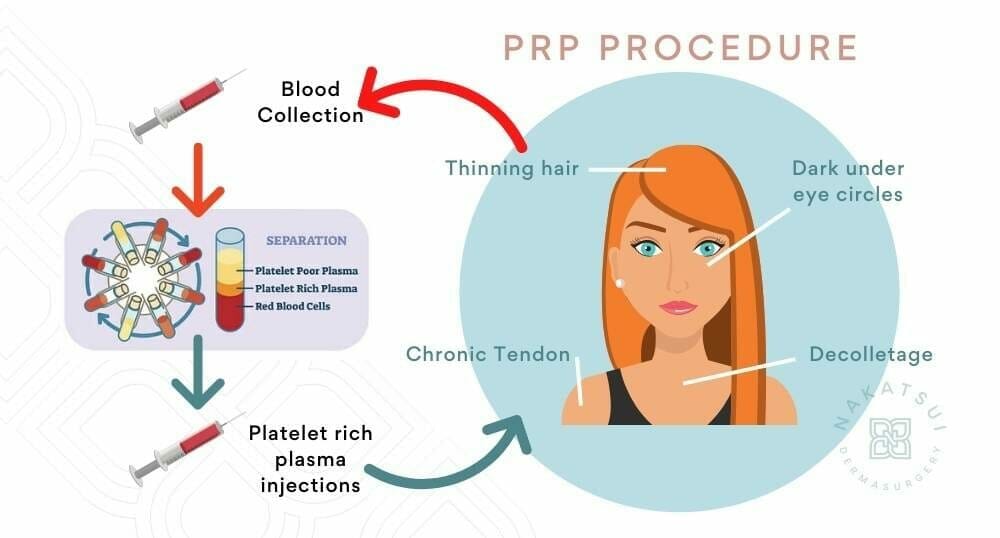Platelet Rich Plasma (PRP) Injections

What is Platelet Rich Plasma (PRP)?
Platelet rich plasma, or PRP, is the process where Dr. Nakatsui uses your blood, more specifically your platelets, and injects it into areas of thinning hair and crepey skin. PRP is a solution of highly concentrated platelets surrounded in its own plasma. Dr. Nakatsui and his staff are able to derive a high concentration of biological nutrient-rich cells and create autologous platelet rich-plasma. Our dermatologist has found it primarily useful for stimulating hair regrowth, although it can also be used for skin rejuvenation and is used in other areas of medicine to treat acute and chronic soft tissue injuries.
What does PRP do for skin and hair rejuvenation?
The goal of PRP for skin rejuvenation is to improve collagen and elastin content, skin texture, and elasticity. PRP can:
• treat dark circles/hollow tear troughs under the eyes
• rejuvenate the nasolabial and/or marionette lines (the deep, sunken areas around your mouth)
• help with the crepey skin texture that we can experience around our eyes
• help thicken up thinning hair.
PRP therapy is frequently combined with other facial rejuvenation and anti-aging treatments such as fillers and BOTOX® Cosmetic, microneedling (sometimes called a vampire facelift when used in combination with PRP), or RF microneeding.

What is involved in a treatment?
In a typical treatment, blood is withdrawn from your arm, identical to when you donate blood or go for medical blood work. The sample is placed in a centrifuge that spins the sample very rapidly for 10 minutes. What happens in the centrifuge is that the heavier particles and heavier aspects of your blood, primarily the red blood cells, begin separating from the plasma.
Once the plasma and the red blood cells are separated, the platelet-rich plasma which contain a high number of growth factors is withdrawn and then injected into the areas of the skin that you are concerned about.
Typical treatments will take approximately 30 minutes. The recommended treatment protocol is 3 treatments spread apart by 1 month each treatment. Then 1 follow up treatment every 6-12 months.

How does PRP work?
Within our blood is a fluid called plasma. Within this plasma are platelets. These platelets contain healing growth factors and it is these growth factors that give instructions to your tissue to regenerate and multiply. Platelet-rich plasma is a technology that deploys aspects of blood-based biochemistry. Because all constituents retrieved in PRP are exclusively from the patient (autologous in origin), there is virtually no risk of intolerance.
Platelet Rich Plasma is also used for a variety of other medical reasons. Due to the high healing ability and almost zero risk of side effects, PRP is used in dentistry, tendon, ligament, and muscle healing, and reduction of inflammation just to name a few.
Some of the known growth factors include:
Transforming Growth Factor (TGF)
Promotes angiogenesis which is the physiological process involving the growth of new blood vessels.
Fibroblast Growth Factor (FGF)
Promotes angiogenesis, granulation, and epithelialization for the intricate process of Tissue repairing itself after injury.
Platelet-Derived Growth Factor (PDGF)
Attracts macrophages and fibroblasts to the zone of injury. Promotes collagen growth and proteoglycan synthesis.
Interleukins, Macrophages, Keratinocytes, Endothelial Cells, Lymphocytes, Fibroblasts, Osteoblasts, Basophils, Mast Cells
Activates fibroblast differentiation. Induces collagen and proteoglycan synthesis for healthy cell production and repair of damaged tissues.
Collagen Stimulating Growth Factor
Stimulates granulocyte and macrophage proliferation for the growth of healthy tissue and blood cells.
Keratinocyte Growth Factor (KGF)
Keratinocyte migration, differentiation, and proliferation may optimize conditions for healing and the generation of new skin.

Does PRP hurt?
PRP injections are minimally uncomfortable. Part of the discomfort related to PRP therapy is related to the amount of residual red blood cells left in the plasma. Interestingly, our Eclipse PRP system has a gel that separates the red blood cells from the plasma. As a result, we have found that our patients have less discomfort than with our previous system.
What are the side effects of a PRP injection?
In and of itself, PRP is extremely safe because it is derived from your own blood. Therefore, there is no chance of having an allergic or immunologic reaction. Side effects of PRP therapy are extremely rare, the main risk being infection (as you might expect from any injection into the skin or scalp)
Want to Find out More?
If you would like to learn more about PRP injections at our skin care clinic, call Nakatsui DermaSurgery (formerly Groot DermaSurgery Centre) at 780-482-1414 to schedule a complimentary consultation with our dermatologist or you can contact us via email using the following link.
